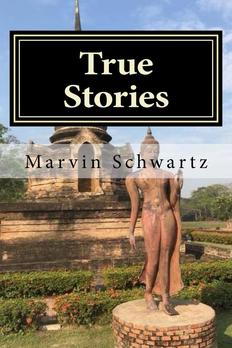|
Reader comments and reviews
"I’ve enjoyed reading other books Marvin has written, but this one captures the essence of who he is and what interesting journeys he has taken in life." "In True Stories Marvin Schwartz—writer, teacher, musician—reveals himself to have once been a hitchhiker, weed-smoker, swimming addict, and more. Item 2, “Pastures of Plenty,” is worth the price of admission. In it Schwartz recounts a New York-to-California thumbing that lands him in a San Francisco commune. Where he prospers, after a fashion, until he’s tempted to attend Woodstock! Will he or won’t he join up with Tom, Carol, Susan and Leatta (fellow commune residents) in a VW camper for a new journey? If he does, will they or won’t they run afoul of the law in Nebraska? Only a reader can know for sure." "True Stories number only six, which is their only shortcoming, for at the end you are left yearning for more—more of the pictorial prose that illuminates the squalid slums of Guatemala, the indulgent hippie society of California, a Nebraska jail cell block, a rural Arkansas burial, or the mind of a right-wing Arkansas editor, and more of Marvin Schwartz’s fateful twists of self-discovery when he briefly inhabits all those exotic cultures." Ernie Dumas, Contributing Editor, Arkansas Times "True Stories form an impressionistic memoir ........ The centerpiece of the book “Confessions of Distance Swimmer,” perceptively analyzes the obsessive compulsion of high-level adult amateur athletes. ..... There’s an earnest quality to Schwartz’s prose that has survived professionalism, an equanimity pervading the straight-forward words that drive his freighted stories."
Philip Martin Arkansas Democrat-Gazette |
“True Stories” offers a portrait of American history and culture that spans a century.
In 1910, a newly-arrived immigrant sees the Statue of Liberty and makes a bold gesture of feminist independence. In 2010, a rural Arkansas cemetery is the site for church funeral with an unexpected hilarious ending. In the years between, a cross-country hitchhiking trip includes an interlude in a Nebraska jail, a Guatemala travelogue tells of a near-disaster drug search, and an adult swimming competition reaches a fateful conclusion. “True Stories” presents a journey of self-discovery, moving from reckless youthful engagement to a mature compassion. Introduction to True Stories:
Memory and Truth These essays question the accuracy of memory and our reliance on it for truth. For memory is a most unstable witness, its testimony easily compromised by the passage of time. Memory will affirm things never seen and deny what was before one’s eyes. Memory hesitates as it searches itself, feeling its way in darkness from room to room, and it frequently stalls, leaving one staring at a blank wall, wondering if something should be there, a picture in frame, perhaps, something one cannot recall. True Stories, call it a memoir if you wish, tells of significant persons and dramatic encounters in my life. The activities described occur between 1910, the year my immigrant grandmother arrived in America, and 2010, when my wife’s mother was buried in a small, rural cemetery in Arkansas. The stories tell of confrontations and crisis situations sometimes avoided, sometimes not. In several of the stories, spontaneous comments reveal who I thought I was at the time. The reckless young man who journeyed out to experience the world now looks back with a perspective that did not exist at the time. He sees more than he did years earlier. He also sees less. As yesterday’s clarity loses its edge, precise recollections begin to blur. But while portions of the original experiences get lost, a better understanding is gained of the actions performed at the time. There’s the rub. Though I have less to work with, less to remember, I am better prepared to find meaning in the memories that remain. And as these stories are selective, they are incomplete. For the memory that preserves them is itself an artifice. When I remember something, there is truth in my telling of it, though my telling of it may not reflect the accuracy of the event. Much happens that we do not or choose not to see. We remember or forget what we wish, and at times, we fill in the blanks with what fits our context. And somewhere in the gap between all we have done and the memories that cling to those moments, we assign meaning. And we call these the true stories of a life. April 2018 Little Rock, Arkansas |

